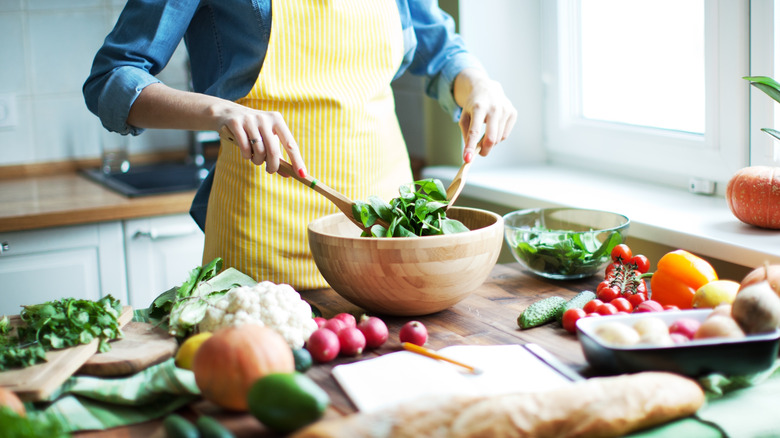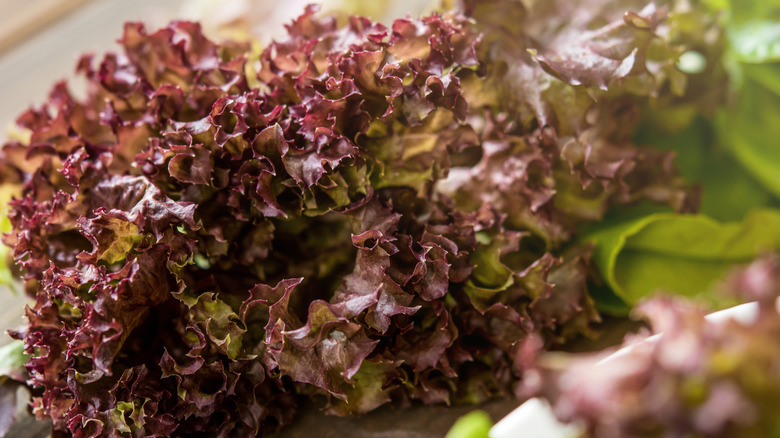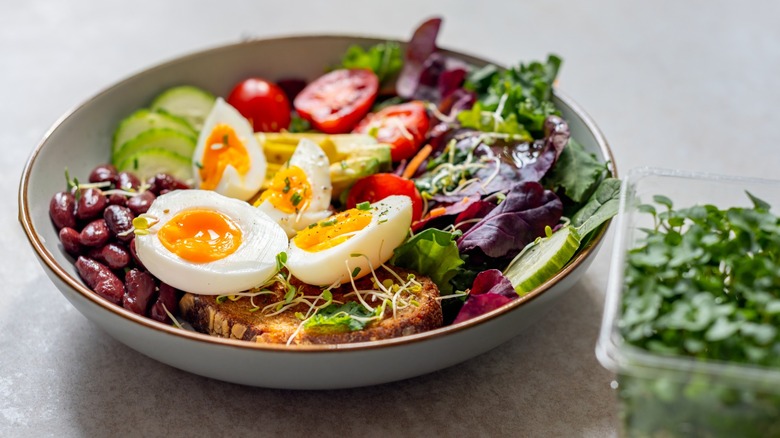The Underrated Lettuce You Should Add To Your Salad
Whether pairing it with a homemade steak dinner or enjoying it as a standalone meal, salads are refreshing entrées and side dishes that are as classic as they are customizable. Necessary as they are, it's easy to get stuck making the same salad over and over, and knowing just how nutritious veggie and fruit-packed salads are, it's important to mix things up (literally and figuratively) so you can keep them in your rotation of meals.
While leafy greens are the quintessential salad base, there's one underrated lettuce with a pop of color that you should add to your roster of salad ingredients: red leaf lettuce. Red leaf lettuce is a crisp, hydrating, water-dense vegetable packed with essential vitamins and antioxidants, making it just as nutrient-rich as other greens commonly added to salads. Its flavor is characterized by a subtle sweetness curbed by pleasant whispers of earthy bitterness that's more snappy than acrid, offering your salad a more complex flavor profile shaded with appetizing nuance.
The scalloped trimming on its edges and crinkly, pocketed surface also makes red lettuce adept at trapping seasonings, flaky salt, and salad dressing, ensuring that each bite of salad is packed with flavor. And thanks to its deep purple color, red leaf lettuce can zhuzh up the aesthetic of your salad presentation, making it that much more appetizing.
Selecting high-quality red leaf lettuce
Whether it's a salad or spicy sriracha shrimp, any great meal starts with high-quality ingredients. Knowing how to select healthy, fresh, well-maintained red leaf lettuce allows you to receive all of its benefits. When shopping for lettuce, a quick visual inspection should be enough to determine its quality.
Inspect the leaves for any signs of damage, such as tears, holes, or browning and bruising on its surface and edges. Although bruised and damaged red leaf lettuce doesn't automatically indicate rotten produce, these imperfections can expedite the decay process, so it's best to opt for heads that look clean and tidy. Similarly, the leaves should look lively, plush, and perky. If you notice wilting or sagging, keep searching.
Though it might sound elementary, you should never purchase or cook with red leaf lettuce tainted with mold or any other organic growth. Surprisingly enough, dirt doesn't indicate low-quality red leaf lettuce. Lettuce is grown in soil, and residual earth can cling to its flesh, but with proper washing, it will come right off.
Pairing red leaf lettuce with other salad ingredients
A salad is only as good as the ingredients that go into it, which means pairing red leaf lettuce with the right provisions is crucial for developing harmonious, crave-worthy flavors. But don't fret, there's plenty to choose from. Red leaf lettuce boasts a classic vegetal flavor, and you can curb any notes of bitterness with something sweet. A red leaf salad with plums, apples, dried cranberries, or even candied nuts can balance out the earthy taste of this colorful lettuce.
If you don't like mixing savory and sweet flavors, try curbing any bitterness with something rich such as freshly grated Parmesan cheese, mozzarella, or ranch dressing to round out the flavor profile of the salad. The mouthfeel of your salad can inform the overall dining experience, and textural contrast helps develop a more dynamic and structured dish. Nothing adds crunch to a tender red leaf lettuce salad quite like croutons, and you can opt for varieties dusted with seasoning to add more flavor.
If croutons aren't your thing, nuts and seeds work just as well. Introducing other ingredients to the red leaf lettuce base like arugula for peppery spice, warm rice for comfort, and succulent chicken to satiate can help fill out the salad to make it a more robust meal. Just don't forget to pair your salad with wine or a tall glass of tea to wash it all down.


